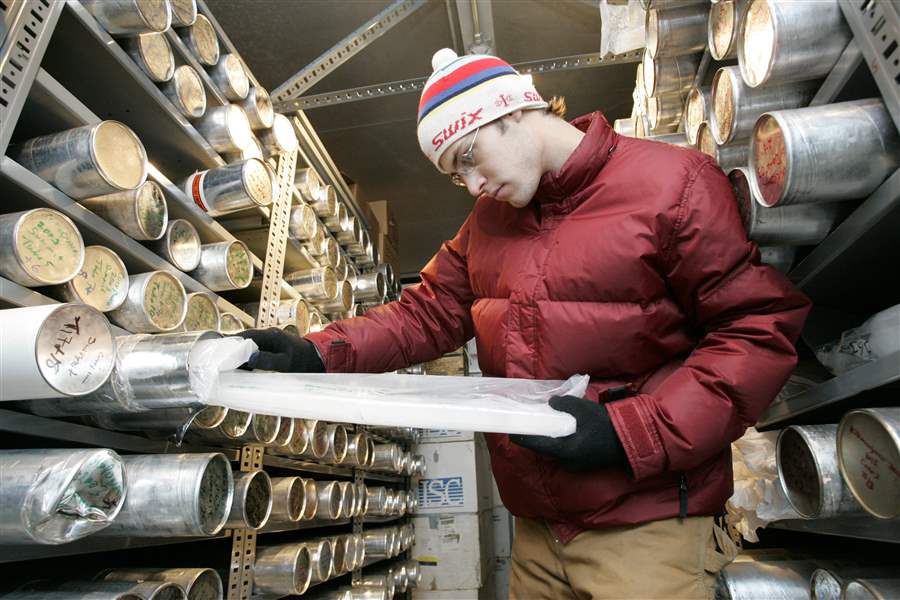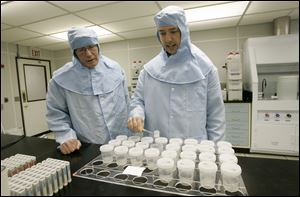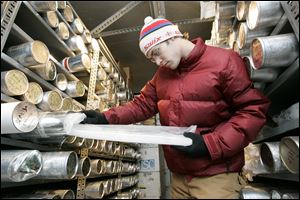
ON THIN ICE
Ohio State facility holds eons of atmospheric history
Ice cores trace conditions as far back as 750,000 years
10/12/2008
Graduate research associate Aron Buffen pulls an ice core from the deep-freeze storage unit.
The Blade/Dave Zapotosky
Buy This Image

Researcher Lonnie Thompson, left, and Matt Makou, a post-doctoral investigator, analyze ice cores in the clean room at the Byrd Polar Research Center.

COLUMBUS -- Scott Hall on Ohio State University's west campus is an unlikely place to find some of the world's top climate-change research.
A nondescript building that's about a 20-minute stroll from one of college football's most glorified stadiums, Scott Hall is home to the Byrd Polar Research Center.
For nearly 50 years, the center - named after explorer Admiral Richard E. Byrd - has brought together climatologists, glaciologists, and oceanographers to study opposite poles of the Earth.
The center's star attraction is its collection of ice cores.
Cylindrical-shaped tubes pulled from ice sheets in Greenland and Antarctica, as well as from glaciers in some of the highest mountains of Alaska, Africa, Bolivia, China, Russia, and Peru, are stored indefinitely in a cryonics-like deep freeze unit.
READ MORE: On Thin Ice -- How global warming is changing our world
The coldest storage unit is maintained at a constant minus-40 degree temperature, with backup generators just in case the main power on campus goes down. When it's time to enter the center's laboratory - known as the "clean room" for painstaking efforts the Byrd center takes to keep samples from being contaminated - ice-core samples are removed from metal canisters and sliced.
The ice is important because it reveals stories about atmospheric conditions going back thousands of years before man inherited Earth. It includes changes since then, especially from pollution generated since the industrial age began about 1850.
Each layer is studied the way tree rings or cylindrical soil samples are examined.
Some offer a look at the fallout from Earth's atmosphere as far back as 750,000 years ago. Ash from an ancient volcanic eruption can be found. So can newer phenomena, such as radioactive particles from the era of atomic bomb testing and the rise of nitrogen and phosphorus-based fertilizers.
The ice doesn't lie.

Graduate research associate Aron Buffen pulls an ice core from the deep-freeze storage unit.
"Anything that's in the atmosphere comes out in the ice. The beauty of these ice sheets and ice caps and glaciers is they just sit there and collect what's in the atmosphere," said Lonnie Thompson, who established the center's Ice Core Paleoclimatology section 32 years ago with his wife, Ellen Mosley-Thompson.
Mr. Thompson has led 54 expeditions to ice caps and glaciers on five continents. Last year, he was awarded the National Medal of Science, one of the highest awards bestowed on American scientists.
The Thompsons were advisers to Al Gore when the former vice president made his Oscar-winning documentary, An Inconvenient Truth. Mr. Thompson appeared in the 2006 film, as well as in Mr. Gore's book by the same name.
Ice at the Byrd center is an important archive of Earth's history. "The value of that archive goes up every year as glaciers disappear," Mr. Thompson said.
The center's other features are less visible, though they play similar roles in preserving history and advancing the country's understanding of climate change.
The U.S. Polar Rock Repository is housed at the Byrd center. Researchers from across the country can check out rocks from the North and South poles.
The rocks give more clues about how the Earth evolved, containing anything from ancient pollen residue to minerals that can yield information about volcanic activity.
The Byrd Polar Research Center also has computer-driven climatology work, research into sea level rise and warming ocean currents, data from satellite imaging of the poles, and mapping of Antarctica in collaboration with others.
Ohio State committed itself to becoming a repository for polar data in 1957. It created the Institute of Polar Studies in 1960 to bring experts from several disciplines under the same research umbrella.
The institute acquired its first set of Admiral Byrd's papers in 1985. Its name was changed to the Byrd Polar Research Center in 1987.